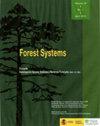阿根廷查科干旱地区保持原生森林连通性和保护的林带义务的有效性
IF 0.7
4区 农林科学
Q3 FORESTRY
引用次数: 1
摘要
研究目的:查科地区是拉丁美洲主要的森林砍伐热点之一。林带,即围绕耕地的原生林带,是在1980年代末建立的,旨在减轻风蚀的影响,并作为保护和连接剩余原生林带的一种方式。本研究的目的是评估在保护原始森林中批准新农业用地的方案的有效性。研究领域:阿根廷查科省、圣地亚哥德尔埃斯特罗省、萨尔塔省和福尔摩沙省最近农业扩张的核心。材料和方法:在地理信息系统中,利用1988年和2015年的卫星图像对景观结构、森林连通性和离开林带义务的遵守情况进行了评估。主要结果:林带在结构上不同于其他森林斑块,呈现出较大的周长/面积比和较小的平均大小。景观连通性的严重丧失,法规的合规性低于预期,达到最低规定宽度的林带很少。各省之间存在显著差异。研究重点:林带不能有效地保护和连接原生森林斑块。鉴于需要进行新的土地清理,应提出其他替代方案,使剩余的森林保留为少数大块,并在景观和景观外尺度上相互连接,并尽量减少边缘效应。本文章由计算机程序翻译,如有差异,请以英文原文为准。
Effectiveness of the obligation of keeping forest strips for native forest connectivity and conservation in the dry Chaco, Argentina
Aim of study: The Chaco Region is one of the main deforestation hotspots in Latin America. Forest strips, i.e. native forest strips that surround cultivated areas, were established by the end of 1980’s as an attempt to mitigate the effects of wind erosion and as a way of conserving and interconnecting the remaining native forest patches. The aim of this study is to assess the effectiveness of the scheme for the authorization of new agricultural land in the conservation of native forests.
Area of study: The most recent nuclei of agricultural expansion in the provinces of Chaco, Santiago del Estero, Salta and Formosa, Argentina.
Materials and methods: Landscape structure, forest connectivity and compliance with the obligation of leaving forest strips was assessed in satellite images for the years 1988 and 2015 within a Geographic Information System.
Main results: Forest strips differ from other forest patches in structure, presenting a greater perimeter/area ratio and smaller mean size. A great loss of landscape connectivity, lower than expected compliance of regulations and few forest strips with the minimum mandatory width were observed. Notable differences between provinces were found.
Research highlights: Forest strips would not be effective to conserve and interconnect the native forest patches. In light of new land clearings, other alternatives should be proposed in which the remaining forest persists as few large fragments with landscape and extra-landscape scale interconnection and minimizing the edge effect.
求助全文
通过发布文献求助,成功后即可免费获取论文全文。
去求助
来源期刊

Forest Systems
FORESTRY-
CiteScore
1.40
自引率
14.30%
发文量
30
审稿时长
6-12 weeks
期刊介绍:
Forest Systems is an international peer-reviewed journal. The main aim of Forest Systems is to integrate multidisciplinary research with forest management in complex systems with different social and ecological background
 求助内容:
求助内容: 应助结果提醒方式:
应助结果提醒方式:


